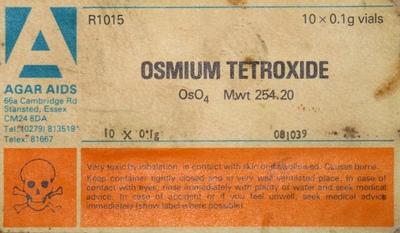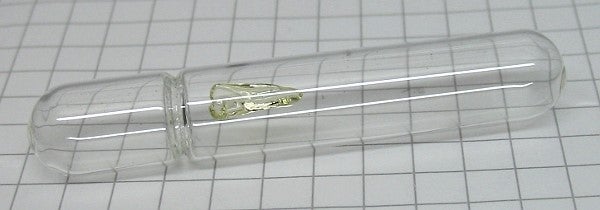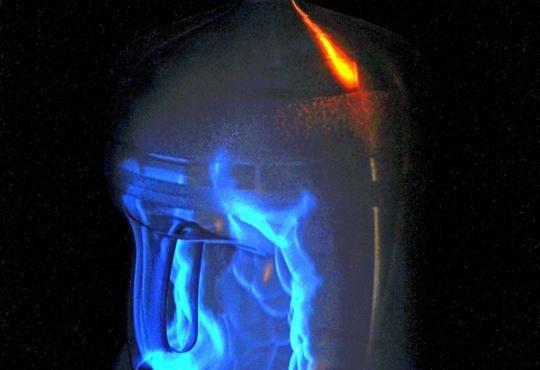Editor’s note
Osmium tetroxide has made the news in Canada and worldwide when Christopher Phillips, a Halifax man, was charged with possession of a dangerous weapon. In January 2015, the Royal Canadian Mounted Police found “floor to ceiling” stacks of chemicals — many unlabelled. One chemical that was identified in the new reports was osmium tetroxide. The media have described this compound as “strange”, “dangerous”, “expensive” and “rare”. It has been in the news before, back in April 2004. When was implicated in a UK foiled terrorist plot. We thought Chem 13 News readers would want more information about a compound that is making headlines.

Photo taken from “Science made alive” website http://woelen.homescience.net/science/ index.html.
With a little research we found the Molecules of the Month website which included the type of information most teachers would want to know. The article was originally posted in May 2004 — after the foiled plot in the UK — and is reprinted with permission. The Molecule of the Month website is one of the longest running chemistry webpages on the internet. The first article on mauveine dye was posted in January 1996. Since then each month has explored a different molecule, many of which are molecules making the news in some way. With interesting information on over 240 molecules, we highly recommend visiting this site. It is a great source of information, ideas and potential fodder for test questions.
Osmium tetroxide (OsO4)

OsO4 – Osmium tetroxide is probably the best known compound of osmium, an element that can easily be found just two places below iron in the periodic table. Osmium tetroxide is inextricably linked to the discovery and subsequent purification of osmium.
Osmium
Osmium is a scarce metal found in only 0.005 ppm of the Earth's crust. Tennant discovered osmium in 1803 in the residues left behind when crude platinum and other precious metals had been dissolved in aqua regia (c.HNO3/c.HCl). It is named from the Greek word for odour (osme). Osmium is also found, often with Ru and Ir, in the anode sludges produced during the electrolysis of nickel(II) solutions. Osmium has an exceptional density of 22.57 g cm-3 and a very high melting point of 3045 °C.

Osmium tetroxide (0.1 g) in an ampoule (commons.wikimedia.org/wiki/File:Osmium_tetroxide_0.1_gram_in_ampoule.jpg)
Osmium tetroxide
Osmium tetroxide is also known as osmium(VIII) oxide. OsO4 is an example of the highest oxidation stated achieved by a transition element. Like methane (CH4), osmium tetroxide has a tetrahedral geometry with the O-Os-O bond angle(s) approximating 109.5º. It is an extremely toxic crystalline solid with a low melting point of 40 ºC and boiling point of 130 ºC. The powerful combination of high toxicity and high volatility (easily evaporates) makes osmium tetroxide dangerous if not stored or handled correctly. Recent media exposure suggested its use as a “billionaire’s chemical weapon”. This Molecule of the Month article is written to show how important this reagent is, to the chemical community, and how it was partly to the awarding of the 2001 Nobel Prize in Chemistry to K. Barry Sharpless. [Shared Nobel Prize — awarded for work with chirally catalysed oxidation reactions.]
Osmium tetroxide is probably colourless1 but is sometimes described as yellow (see photo above). I suggest this discrepancy lies with the presence of the impurity OsO2, which is yellow-brown in colour.2 It is very soluble in CCl4 (carbon tetrachloride or tetrachloromethane) and moderately soluble in water. OsO4 has a characteristic ozone-like odour. The smell is recognisable as the 'fresh' smell you get from old photocopiers, when near someone welding, or to be sniffed on a sunny summer day in a heavily congested city. You may also smell ozone should you be close to a lightning strike, and this event is far more likely than being close to a terrorist atrocity.
Osmium tetroxide is particularly hazardous to the eyes as it is readily reduced by living tissue to give a black oxide, osmium metal or both. For this reason it finds itself an important use as a biological stain in dilute aqueous solutions.
Preparation of osmium tetroxide
Addition of oxygen (oxidation) is possible by burning the metal at 800 °C.
Os + 2O2 → OsO4
An alternative preparation is the oxidation of osmium salts with c.HNO3. This is a widely used method to recover osmium via the volatile osmium tetroxide.
Reactions
OsO4 is a more powerful oxidizing agent than the halogens. It oxidizes the halides — Cl-(aq), Br- (aq), I- (aq) — to their respective halogens. One easy way to recognise oxidations is an increase in oxidation number (from 1- in the halides to 0 in the elemental halogens).
2Cl-(aq) → Cl2
OsO4 + 2OH-(aq) → [OsO4(OH)2]2-
This above reaction is interesting for a number of reasons, for example the surprising colour change, osmium expands its coordination sphere to six, the product is diamagnetic and the OH groups are trans (opposite each other).
Specialized use in organic chemistry
OsO4 is a convenient reagent for the same side (syn) addition of two OH groups across a carbon-carbon double bond. Osmium tetroxide was first given this use back in 1936 by Criegee and a good source of information on this powerful oxidizing agent is a 1980 review article on dihydroxylations.3
This is a rather slow addition but has the distinct advantage of being almost quantitative, an important consideration when performing multi-step syntheses of natural products.
A more familiar reagent that also adds two OH groups across a double bond is alkaline KMnO4. This is a reaction which used to be taught at A-level and is perhaps more interesting than the often-quoted 'decolourise bromine water' test for unsaturation. Fortunately the high cost of osmium tetroxide does not preclude its use by perennially underfunded chemical research groups because the same reaction can be achieved catalytically, either with OsO4 combined H2O24 or combined N-methylmorpholine-N-oxide5. I also made use of this reagent during my own research with Professor Pettit.6
Conclusion
Osmium tetroxide is a valuable tool in the research of both chemists and biologists, and needs to remain so. Chemists need to protect their interests, perhaps more overtly in the future, and ensure that they continue with their important work against the tide of negative publicity concerning the misuse of chemicals by non-chemists.
References
- I.S. Butler and J.F. Harrod, Inorganic Chemistry: Principles and Applications, 1989, page 343
- A. Cotton and G. Wilkinson, Advanced Inorganic Chemistry, 4th edition, page 905. In the original posted article, the edition of Cotton and Wilkinson was not specified. Chem 13 News looked up the information in the 4th edition. Here OsO2 was described as “coppery” and OsO4 was described as “colourless crystals”.
- M. Schroder, Chemical Reviews, Osmium tetraoxide cis hydroxylation of unsaturated substrates, April 1980, pages 187-213.
- N.A. Milas & S. Sussman, Journal of the American Chemical Society, The Hydroxylation of the Double Bond, July 1936, 1302.
- V. Van Rheenan, R.C. Kelly and P.Y. Cha, Tetrahedron Letters, 1976, page 1973.
- G. Pettit, N. Melody, M. O’Sullivan, M. Thompson, D. Herald and B. Coates, Journal of the Chemical Society, Chemical Communications, Synthesis of 10b-R-hydroxy-pancratistatin via narciclasine, 1994, pages 2725-6.
Editor’s comments
The Sigma-Aldrich price for OsO4 is CAN $341 per gram. Although the sample shown in the news and this article have a distinctive yellow appearance, researchers we talked with at the University of Waterloo said the OsO4 they have used was colourless.
Possible student questions
Calculate the number of moles of osmium in the ampoule shown above. What is the volume of this sample?
Determine the oxidation state of osmium in OsO4 and [OsO4(OH)2]2-.
What is the product when cyclopentene is treated with osmium tetroxide followed by sodium sulfite?







